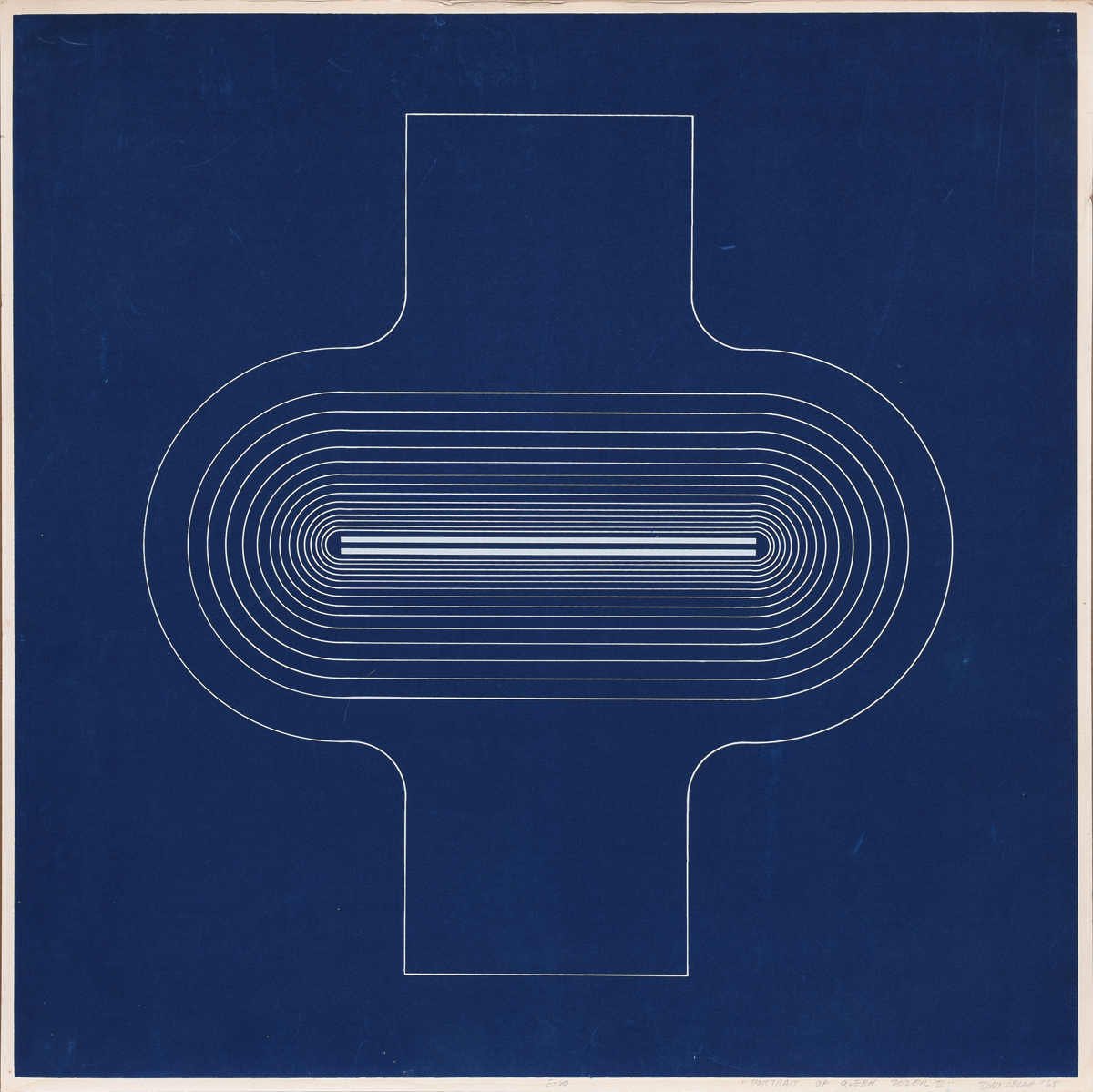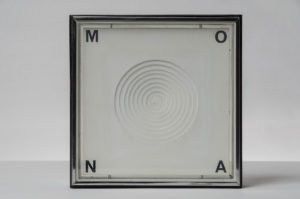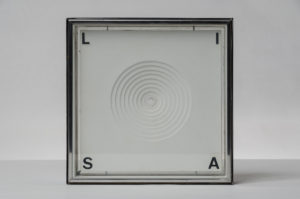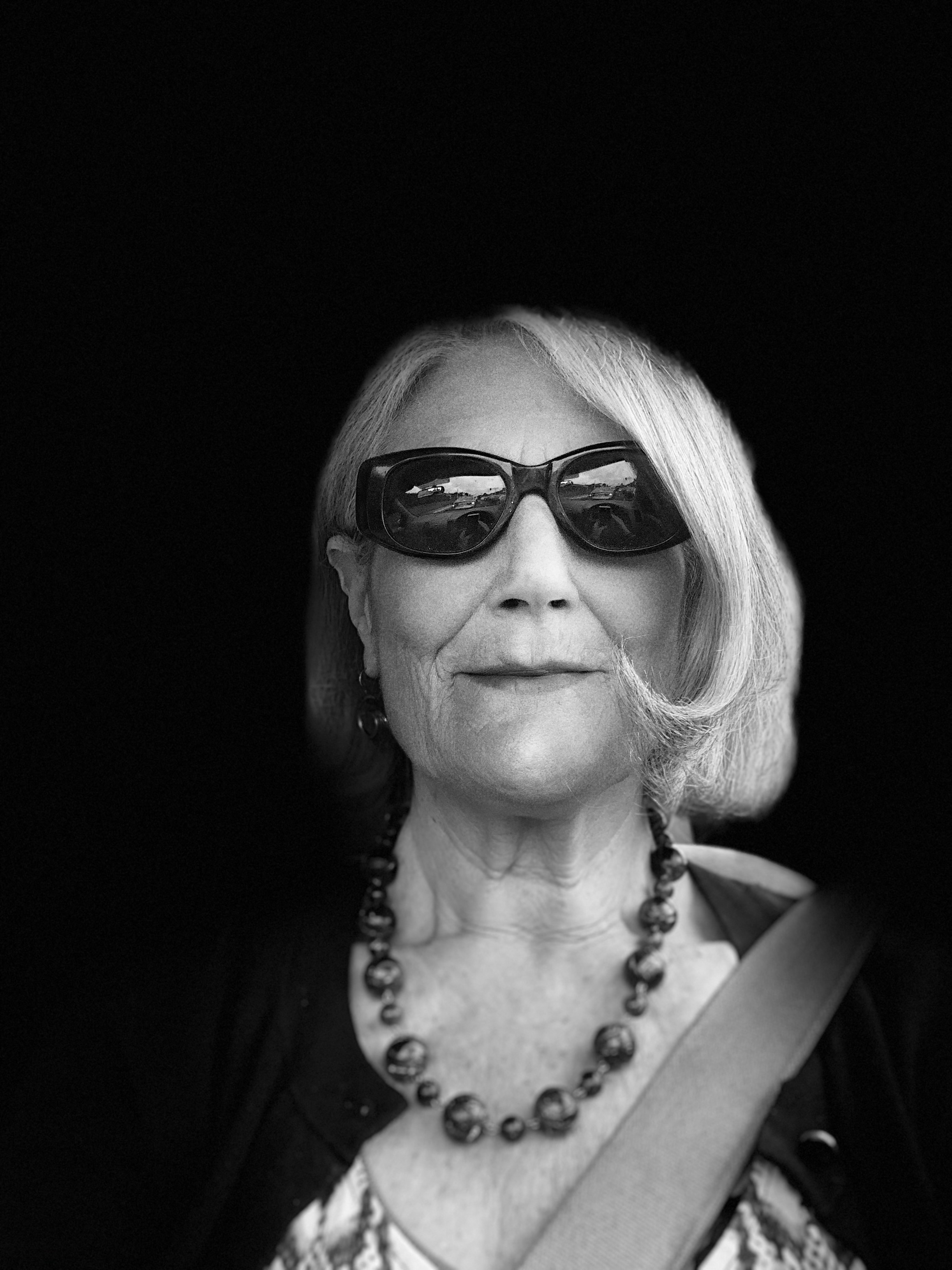
“Tony DeLap: A Retrospective” begins where exhibits usually end at Laguna Art Museum, in the medium-sized gallery. It’s as if curator Peter Frank needed a larger space to contain DeLap’s great turning point in the early 1960s. Reminiscent of Joseph Cornell’s boxes, thick assemblages under glass hang on the left wall, including Charlie McCarthy (1963), which features deep hues with circles cut into the layers, a few dice popping to the surface.
During the time DeLap was working on these collages, he visited a Frank Lloyd Wright house and “saw the light streaming through the perforated brick” surrounding the property. He began to create two-sided paintings of depth, not with perforations, but a series of step-downs that lead ever deeper into the works. You can see through them where the mirrored step-downs meet. On a pedestal sits the 10-inch-square Mona Lisa (1962), the size and thickness of the architect’s bricks, with circular step-downs all in white. A black letter appears in all eight corners, spelling “Mona” on one side and “Lisa” on the other. If you get eye-level with the center of the concentric circles, you see not a hole to peep through, but rather a dot on the glass—a total surprise and much closer than anticipated.
The Oakland-born artist made only about a dozen of these transfer-letter pieces, including Flip Flop (1962-63), in a gleaming cobalt blue not unlike a Noxzema jar. At 22 inches high, 12 across and 4 deep, it stacks two elongated-oval step-downs on each side; a 3-D diamond appears where they meet.
Another painting/sculpture hybrid, Zanzig (1968) is a thick metal hexagram that sits sturdily on its bottom side. Two burgundy step-downs are set in parallel diagonals, a slant that causes the illusion that Zanzig is about to roll right off its pedestal.
The flawless execution of the treads into these constructions continues among the 80-some artworks in the retrospective, which is a worthy homage to the 90-year-old master. No matter the size or material DeLap has used in his career, the craftsmanship is impeccable.
His next innovation moved paintings back onto the wall, with edges that are as crucial as what is seen from the front. “I didn’t want the painting to be over,” DeLap told filmmaker Dale Schierholt in Tony DeLap: A Unique Perspective. In the documentary, DeLap’s devotion to magic comes to life as he performs gasp-inducing card tricks. To explain his edge-work, he palms a deck and twists the top cards, turning the edge from straight into a curving triangle. That hyperbolic edge, particularly in wood, appears in marvelous ways in the exhibit’s most thrilling space.


The museum’s largest gallery is filled floor to ceiling with shaped paintings and sculptures that use all 70 feet of the room’s diagonal. A platform displays small-scale sculptures that experiment with lean as well as twist. The Great Escape (1972) is suspended just inside the room and contains a big reveal.
Esoterist (1990) attracted me with its vibrant purple hue and aerodynamic shape. As I moved toward it, the sweeping wood portion shape-shifted; stunned, I began to see that the top jutted into the room, then curved back and flared out like the seams in a trumpet-bottom skirt. My body jolted the moment my mind understood it had been wrong.
DeLap masterfully plays below the surface of a viewer’s perception as he infuses his love of magic directly into his work. Floating Lady II (1970/2017) is two glass walls that stand thanks to c-clamps, over which a thick, 30-foot wood beam appears to float. For the opening of 1974’s Floating Lady at what is now the Orange County Museum of Art, he floated an actual lady. “We hired Farrah Fawcett’s double,” DeLap told Christopher Michno of Riot Material. “She was paid by how high off the ground she was going.” You can see a photo of the levitation on DeLap’s website.
One of the most charmed aspects of the exhibit is that no matter where you stand in the large gallery, the works interact. Look along Floating Lady II’s beam and see it appear to penetrate the painting Ectoplasm Should Not Be Too Kinky.
Lured down from UC Davis by John Coplans, whose articles in Artforum brought DeLap attention well beyond California’s borders, to help create UC Irvine’s art department, Tony and Kathy DeLap have lived in the same Corona del Mar house since 1965. The cutting edge of West Coast artists partied at that house, right in the craw of conservative, wealthy Orange County.
The first of the smaller galleries is as elegant as a magician’s top hat, with black-and-wood shaped paintings and black sculptures on the floor resembling cuddling lovers. A wall of drawings contains ideas rendered from 1962-2017 across from a space dedicated to DeLap’s outdoor installations. A video by Schierholt plays near maquettes of Floating Lady and The Big Wave (1982), a commission DeLap was proud to win.
Upstairs is not to be missed. Ladies float above Paris in one series; the artist’s hand levitates a stick in another. The luscious blue screenprint Portrait of Queen Zozer II (1968), which appears on the cover of the retrospective’s catalog, contains in lines the step-downs of the hybrids. Queen Zozer (1964-68) hangs nearby all in white, reproducing in three-dimensional cast fiberglass the white lines of Portrait of Queen Zozer II.

In the final gallery are recent hard-edged abstract paintings, which still fill DeLap with anticipation as he pulls off the tape before seeing the completed work. And finally, near the lobby door is Fawkes (1964), in a startling red. When you stand at the wall of drawings, you can turn your head to see Fawkes framed by the small gallery walls. It’s another hexagon, and from the six sides, pie-shaped step-downs eventually meet at the center in a plus sign you can look through. I don’t know how he does it.
Meanwhile, Houdini sits in the lobby, ready to exit. You can see the 6-foot hexagon in aluminum and another delightful blue as you drive south on Coast Highway. At night, the intersection’s lights bounce off its metal planes, producing some lovely California light and magic.
Tony DeLap: A Retrospective” at Laguna Art Museum, 307 Cliff Dr., Laguna Beach, (949) 494-8971; lagunaartmuseum.org. Open Mon.-Tues. & Fri.-Sun., 11 a.m.-5 p.m.; Thurs., 11 a.m.-9 p.m. Through May 28. $5-$7; members and children younger than 12, free.

Lisa Black proofreads the dead-tree edition of the Weekly, and writes culture stories for her column Paint It Black.

